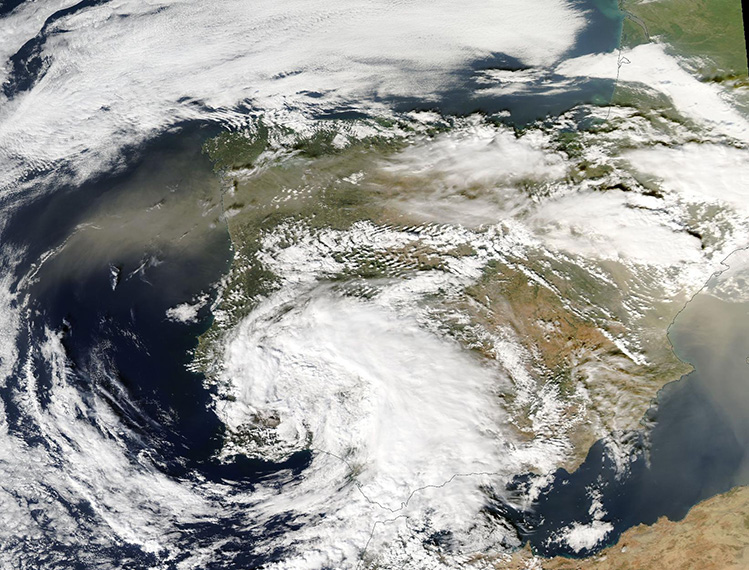Images
November 1, 2024 - Extreme Weather on the Iberian Peninsula
Tweet
Intense rainfall in eastern Spain produced deadly and destructive flash floods in the province of Valencia in late October 2024. On October 29, 2024, more than 300 millimeters (12 inches) of rain fell in parts of the province, reported Spain’s meteorological agency, AEMET. In the town of Chiva, nearly 500 millimeters (20 inches) fell in 8 hours.
The rains came from a high-altitude low-pressure weather system that became isolated from the jet stream, according to AEMET. These storm systems are known locally by the Spanish acronym DANA (Depresión Aislada en Niveles Altos), or more generally as cut-off lows. They occur where cold fronts encounter warm, humid air masses, such as over the Mediterranean Sea. The storms can remain relatively stationary before dissipating, amplifying their flooding potential.
According to a report posted by the Global Disaster Alert and Coordination System (GDACS), the death toll reached as high as 132 people, with 114 people remaining missing. Most of the deaths were in the Valencia Region. More than 3,500 people were reported to have been rescued, with at least 155,000 household without power and 315,000 without water service. News outlets reported that Infrastructure such as roads, bridges, and rail lines sustained damage, and photos show displaced vehicles and debris filling city streets. A military emergency unit deployed more than 1,100 personnel to support rescue operations in the region.
More rain is expected over the region from October 31-November 1, according to GDACS. Heaviest rainfall is forecast to fall over eastern Spain with thunderstorms likely in the Valencia region.
The Moderate Resolution Imaging Spectroradiometer (MODIS) on NASA’s Aqua satellite acquired a true-color image of unsettled weather continuing over the Iberian Peninsula on October 30. At the time, the storm system was dropping less rain than on October 29, but clouds persisted over parts of Spain and Portugal. In addition, strong winds kicked up by the storm brought a thick band of Saharan Dust over the northern part of the Peninsula.
Image Facts
Satellite:
Aqua
Date Acquired: 10/30/2024
Resolutions:
1km (407.6 KB), 500m (1.3 MB), 250m (3.6 MB)
Bands Used: 7,2,1
Image Credit:
MODIS Land Rapid Response Team, NASA GSFC
Tweet
Intense rainfall in eastern Spain produced deadly and destructive flash floods in the province of Valencia in late October 2024. On October 29, 2024, more than 300 millimeters (12 inches) of rain fell in parts of the province, reported Spain’s meteorological agency, AEMET. In the town of Chiva, nearly 500 millimeters (20 inches) fell in 8 hours.
The rains came from a high-altitude low-pressure weather system that became isolated from the jet stream, according to AEMET. These storm systems are known locally by the Spanish acronym DANA (Depresión Aislada en Niveles Altos), or more generally as cut-off lows. They occur where cold fronts encounter warm, humid air masses, such as over the Mediterranean Sea. The storms can remain relatively stationary before dissipating, amplifying their flooding potential.
According to a report posted by the Global Disaster Alert and Coordination System (GDACS), the death toll reached as high as 132 people, with 114 people remaining missing. Most of the deaths were in the Valencia Region. More than 3,500 people were reported to have been rescued, with at least 155,000 household without power and 315,000 without water service. News outlets reported that Infrastructure such as roads, bridges, and rail lines sustained damage, and photos show displaced vehicles and debris filling city streets. A military emergency unit deployed more than 1,100 personnel to support rescue operations in the region.
More rain is expected over the region from October 31-November 1, according to GDACS. Heaviest rainfall is forecast to fall over eastern Spain with thunderstorms likely in the Valencia region.
The Moderate Resolution Imaging Spectroradiometer (MODIS) on NASA’s Aqua satellite acquired a true-color image of unsettled weather continuing over the Iberian Peninsula on October 30. At the time, the storm system was dropping less rain than on October 29, but clouds persisted over parts of Spain and Portugal. In addition, strong winds kicked up by the storm brought a thick band of Saharan Dust over the northern part of the Peninsula.
Image Facts
Satellite:
Aqua
Date Acquired: 10/30/2024
Resolutions:
1km (407.6 KB), 500m (1.3 MB), 250m (3.6 MB)
Bands Used: 7,2,1
Image Credit:
MODIS Land Rapid Response Team, NASA GSFC




